|
Warding Off Evil
Spirits―Egyptian Style
by Bob Brooke
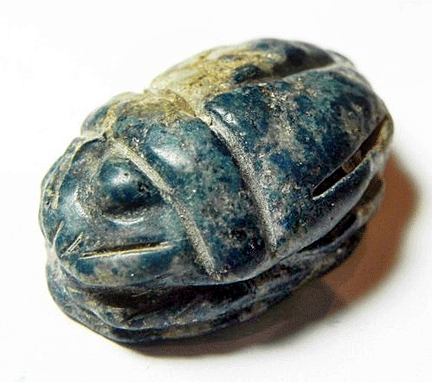 People
everywhere want to avoid disease and other misfortune, and many use
amulets to ensure their well-being. Today, a person might wear a
bracelet made of beads with a concentric circle design to combat the
evil eye or keep a lucky penny in his or her wallet or even have a St.
Christopher’s medal hanging from the rearview mirror in their car. People
everywhere want to avoid disease and other misfortune, and many use
amulets to ensure their well-being. Today, a person might wear a
bracelet made of beads with a concentric circle design to combat the
evil eye or keep a lucky penny in his or her wallet or even have a St.
Christopher’s medal hanging from the rearview mirror in their car.
But the Egyptians took amulets to the extreme. They used amulets for
much of their history, from the Pre-Dynastic Period around 4400 BCE to
the Roman Period in the 4th century CE. Early amulets often took the
shape of animals, while only a few represented gods.
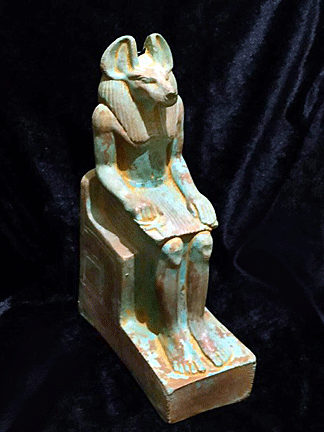 Ancient
Egyptian amulets were both decorative and practical. People considered
them as having powers to protect the wearer. Not only the living wore
them but also the dead. Amulets were abundant and cost very little, so
people in all levels of society could afford them. Ancient
Egyptian amulets were both decorative and practical. People considered
them as having powers to protect the wearer. Not only the living wore
them but also the dead. Amulets were abundant and cost very little, so
people in all levels of society could afford them.
Amulets held different meanings, depending on their type or form. Small
amulets depicting gods and goddesses induced the protective powers of
the deity. On the other hand, small representations of anatomical
features or creatures suggest that the wearer required protection over a
specific body part, or that he or she desired the skills of a particular
animal. Amulets depicting animals were very common in the Old Kingdom
Period, while representations of gods gained popularity in the Middle
Kingdom.
Amulets worn by the living were generally used for the dead as well,
since their benefit also applied to the afterlife. Amulets representing
a goddess or god, for example, occur in both spheres, as they were meant
to invoke the deity’s specific powers. It’s possible that a deity amulet
was used with a very specific hope, but since a god or goddess usually
had multiple meanings, several functions might have been addressed at
the same time.
Types of Amulets
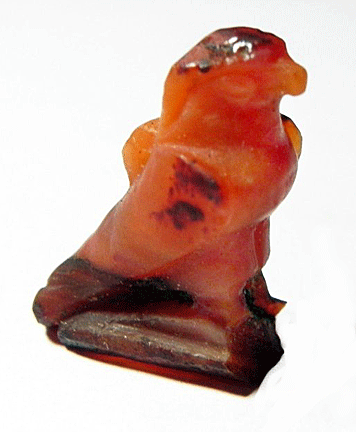 The
magical powers of ancient Egyptian amulets depended on several things,
such as the amulet’s shape, decoration, inscription, color, material,
and words spoken over the piece or acts performed with it. People wore
amulets on their bodies to transfer the powers of the amulets directly
to the owner. Some were pierced or featured a loop, allowing a person to
hang them as pendants on a necklace, Among many other possibilities,
they could be incorporated into rings or enfolded in a piece of fabric
that was then attached to a string, so that amulets could be worn
without having any means of suspension themselves. The
magical powers of ancient Egyptian amulets depended on several things,
such as the amulet’s shape, decoration, inscription, color, material,
and words spoken over the piece or acts performed with it. People wore
amulets on their bodies to transfer the powers of the amulets directly
to the owner. Some were pierced or featured a loop, allowing a person to
hang them as pendants on a necklace, Among many other possibilities,
they could be incorporated into rings or enfolded in a piece of fabric
that was then attached to a string, so that amulets could be worn
without having any means of suspension themselves.
Ancient Egyptian amulets represented animals, deities, symbols, or
objects in miniature. People believed that certain things found in
nature, such as a claw or shell, had magical powers and therefore could
function as an amulet. There were also so-called textual amulets,
usually consisting of a short magical spell written on a piece of linen
or papyrus that was then folded and put on a string. Theoretically,
anything could be made into an amulet through a magical act.
Archaeologists often identify an ancient Egyptian object as an amulet
based on its shape and size, and—in some cases—its use as a pendant.
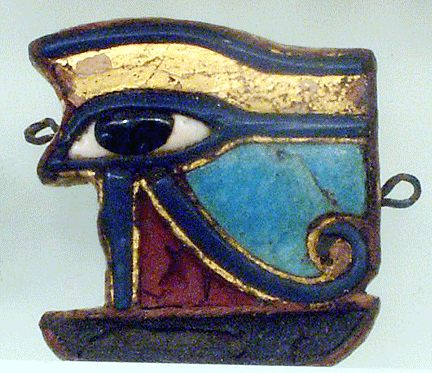 One
of the most common amulets used by the living and the dead is the wedjat-eye
. It depicts the healed eye of the god Horus and is actually a
combination of a human and a falcon eye, as Horus was associated with
the falcon. In Egyptian mythology, Horus’s eye was injured or stolen by
the god Seth and then restored by another deity named Thoth. The
wedjat-eye embodies the healing power used on it and thus symbolizes
regeneration. Appropriately, its ancient Egyptian name means “the one
that is sound (again).” A wedjat-eye amulet was thought to
transfer the power of regeneration onto its wearer and to generally
protect the individual. One
of the most common amulets used by the living and the dead is the wedjat-eye
. It depicts the healed eye of the god Horus and is actually a
combination of a human and a falcon eye, as Horus was associated with
the falcon. In Egyptian mythology, Horus’s eye was injured or stolen by
the god Seth and then restored by another deity named Thoth. The
wedjat-eye embodies the healing power used on it and thus symbolizes
regeneration. Appropriately, its ancient Egyptian name means “the one
that is sound (again).” A wedjat-eye amulet was thought to
transfer the power of regeneration onto its wearer and to generally
protect the individual.
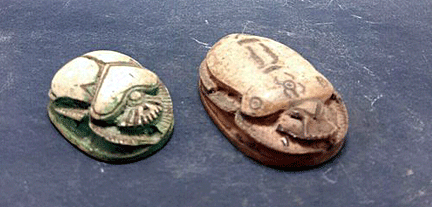 Scarabs
were symbols of life and regeneration, and as amulets they could
transfer these powers. Most commonly, their flat undersides were incised
with very short inscriptions or with symbols or other images, which had
further magical meaning. Scarabs inscribed with the name and title of
the owner were often used as a seal by pressing the underside into a
lump of clay that would then bear an impression of the incised
decoration. Scarabs
were symbols of life and regeneration, and as amulets they could
transfer these powers. Most commonly, their flat undersides were incised
with very short inscriptions or with symbols or other images, which had
further magical meaning. Scarabs inscribed with the name and title of
the owner were often used as a seal by pressing the underside into a
lump of clay that would then bear an impression of the incised
decoration.
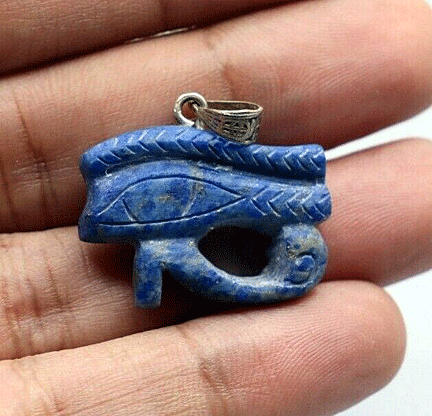 The
Egyptians preferred to use faience for man-made amulets. Amulet makers
could produce it in green and blue colors, favored for their association
with life and regeneration. They also employed semiprecious stones, the
colors of which often had a specific meaning. The Egyptians associated
the color red, for example, with dangerous forces but also considered it
to be protective. They also used expensive materials such as gold,
silver, and electrum for the amulets used by the higher classes of
Egyptian society. The
Egyptians preferred to use faience for man-made amulets. Amulet makers
could produce it in green and blue colors, favored for their association
with life and regeneration. They also employed semiprecious stones, the
colors of which often had a specific meaning. The Egyptians associated
the color red, for example, with dangerous forces but also considered it
to be protective. They also used expensive materials such as gold,
silver, and electrum for the amulets used by the higher classes of
Egyptian society.
Funerial Amulets
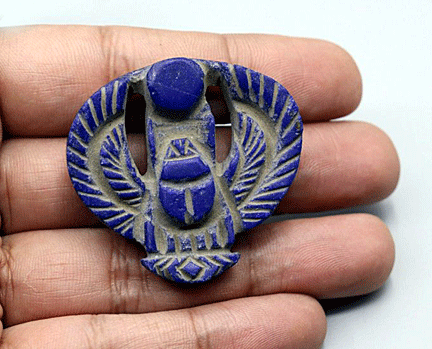 Archaeologists
have discovered amulets inside the wrappings of mummies, thus giving the
deceased powers in the afterlife. Those who prepared the mummies often
placed amulets on the mummy or in between the bandages. While amulets
worn by the living were often small, on average ranging from about ˝ to
2 ˝ inches, funerary ones such as winged scarabs could be as large as
nearly 10 inches wide. Archaeologists
have discovered amulets inside the wrappings of mummies, thus giving the
deceased powers in the afterlife. Those who prepared the mummies often
placed amulets on the mummy or in between the bandages. While amulets
worn by the living were often small, on average ranging from about ˝ to
2 ˝ inches, funerary ones such as winged scarabs could be as large as
nearly 10 inches wide.
Funerary amulets peaked in the Late Period from 664 to 332 BCE, when
many
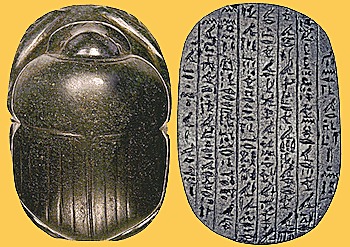 new
types appeared that were only beneficial for the dead, such as the
two-finger amulet. Funerary amulets often referred to the belief that
after death, the heart of a person would be weighed against maat,
the principle of truth and justice. Only if the individual had lived a
righteous life before his or her death was the person allowed to live on
in the afterlife. Understandably, the Egyptians feared a negative
outcome, so they designed special amulets to ensure a positive judgment,
such as heart scarabs. These depict a large scarab beetle with a text
inscribed on its underside that linked the amulet to the weighing of the
heart. new
types appeared that were only beneficial for the dead, such as the
two-finger amulet. Funerary amulets often referred to the belief that
after death, the heart of a person would be weighed against maat,
the principle of truth and justice. Only if the individual had lived a
righteous life before his or her death was the person allowed to live on
in the afterlife. Understandably, the Egyptians feared a negative
outcome, so they designed special amulets to ensure a positive judgment,
such as heart scarabs. These depict a large scarab beetle with a text
inscribed on its underside that linked the amulet to the weighing of the
heart.
Symbols Used in Amulets
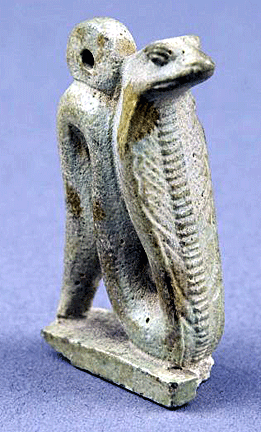 The
cobra symbol comes from the word iaret, meaning “the risen one.” The
Egyptians used cobras rising up in protection on the front of the
headdresses of gods and pharaohs, suggesting the amulet may have been an
emblem of royal and divine power and authority. The
cobra symbol comes from the word iaret, meaning “the risen one.” The
Egyptians used cobras rising up in protection on the front of the
headdresses of gods and pharaohs, suggesting the amulet may have been an
emblem of royal and divine power and authority.
Another symbol is the hare. While its origin is unknown, it may have
been used in amulets to symbolize fertility due to their abundance in
the Egyptian desert
The lion amulet would have endowed the wearer with ferocity and bravery,
as well as the regenerative properties that the Egyptians believed lions
possessed.
The Egyptians believed that amulets in the shape of scarab beetles
represented the sun god, Ra. They believed that the scarab beetle
rolling its ball of dung across the dessert mirrored the journey of the
sun across the sky from day to night. As the beetle laid its eggs within
the dung, it became a symbol of rebirth and regeneration.
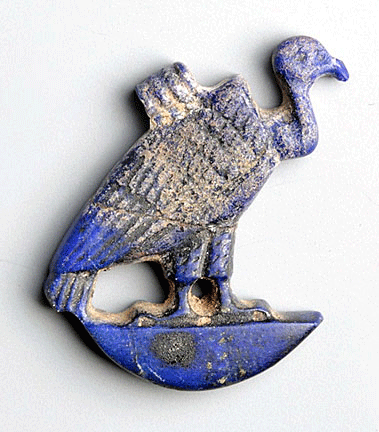 Amulets
of vultures represented the danger to be averted rather than the
intended characteristic of the animal. In this case, the fear may have
been of being devoured. Amulets
of vultures represented the danger to be averted rather than the
intended characteristic of the animal. In this case, the fear may have
been of being devoured.
When an amulet depicted a part of the human body, it supposedly
protected that specific part of the body from harm or illness, and when
placed on the dead, connotations of bodily unity and the integrity of
the mummy itself.
The ancient Egyptians believed the heart to be the seat of intelligence
and the origin of feeling and
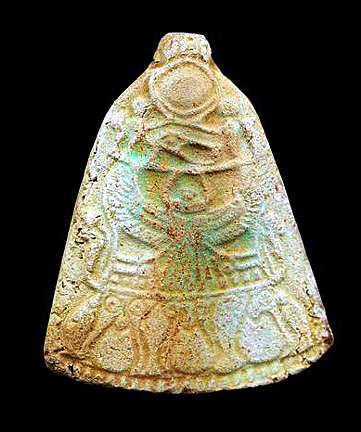 action.
Heart amulets have been found placed on the torso of every mummy. action.
Heart amulets have been found placed on the torso of every mummy.
Ancient Egyptians had gardens and loved to plant flowers. Sometimes,
they strung real flower heads together to be worn by mummies or by the
living, and although their precise significance is unknown, flower
imagery and amulets signified new life.
The lotus stood for rebirth and creation. Lotus flowers opened during
the day and closed at night, thus illustrating the journey of the god,
Khepri, who rolled the sun across the earth, and in doing so created day
and night.
< Back
to Collectibles Archives
Next Article >
|
